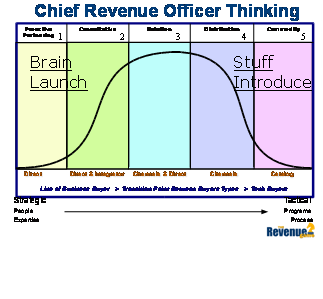Launching is not something CEOs do every day. This is the necessary baseline knowledge about launching that is part of the go-to-market process:
– Go-to-market is the process of getting something to the point that there is a market that wants to buy what the seller wants to sell.
– In the go-to-market process, there are 3 distinct phases:
- Launching
- Introducing
- Executing
– You can’t launch a product until it is integrated into an offer.
– When you go-to-market, you have to pick a side of the buyer’s BellCurve. Your choices are Brain side (launch) or Stuff side (introducing). Brain and Stuff are defined by the buyer’s understanding of the seller’s offer.
- On the stuff side, the seller is introducing the offer into an existing market. In the eyes of the buyer, the offer is the same as or slightly different than other items in the market. The buyers know everything they need to know in order to buy other than the price and availability for this particular offer.
- On the brain side, there is no identified market for this offer. The seller is launching something (phase one of go-to-market) new to the buyer, that the buyer has no idea about what it does or why they should care. On the brain side, the seller must find the buyers, evangelize the offer, prove the buyer will get the full value from the offer at a level of risk they can manage and with a financial return that justifies the risk.
 With that understanding of the go-to-market process, here are 3 myths and 3 facts for those who launch.
With that understanding of the go-to-market process, here are 3 myths and 3 facts for those who launch.
Myth # 1 – You can launch a new product into the market.
Fact # 1 – You can’t launch or sell any product until it is transitioned into an offer. The offer covers the whole buyer experience (value, price, distribution, services, warranty, etc.). Also, you can’t launch into a market. Markets represent a group of buyers who are proactively looking to buy, and since a launch is about something new (that they have never heard of), they can’t be proactively looking to buy it.
Myth # 2 – It is important to price new products low to get the product (offer) into the market or, better yet, give the new product (offer) to a big name user for the reference.
Fact # 2 – The launch is about the seller being very clear about solving a customer problem that no one else is solving or has ever been solved. In solving this problem, the seller is selling their brain (knowledge) as part of the offer. The buyer does not know how this new approach to the problem will work and will only feel safe enough to acquire this offer if the seller’s brain is a major part of the offer in the form of intellectual property like design, training, consulting, installation, integration or ongoing support.
If the offer does not demonstrate the brain as part of the offer and that the fee for the brain is large enough to assure the brain will be available every time the buyer needs it to get the expected outcome, the buyer will not take the risk of acquiring this new offer. The buyer wants to be very comfortable that, in partnership with the seller, the buyer can get from where they are today to the promised land of the offer.
The fee for a brain offer should be 10 percent of the value of the problem solved. If the fee is more than 10 percent of the value of the problem, the risk ratio to the buyer will be too great. If the fee is less than 10 percent of the value, the buyer feels that there’s something wrong.
For a brain offer, the buyer wants to pay a LOT because they want to believe the value is GREAT, and the seller is engaged in the offer until everything meets or exceeds the buyer’s expectations.
Myth # 3 – The best channel to launch a new product is through commission-only sales reps.
Fact # 3 – Indirect channels in general and commission-only sales reps in particular get up every morning, look in the mirror, and ask just one question, “What can I do today to make the most money before dinner?”
Evangelizing a brain offer is NEVER the answer to the question for the person in the mirror. Indirect channels won’t do the long-term work required. They can’t be counted on to meet the seller’s schedule, and most importantly are not trusted by the buyer. Since the buyer is taking a lot of risk, they want the seller team totally committed to the process, and indirect channels don’t normally fit that definition.
Go-to-market is one of the most important skills for a CEO or a CRO (Chief Revenue Officer) to master for the long-term health of the company. Realizing that go-to-market has three phases gives leaders the power to control each one and, as a result, the whole go-to-market process.
Don’t confuse the launch of a brain offer with the introduction of a stuff offer. Both are part of the go-to-market and require execution but the supporting execution is as different as brain and stuff. Developing clarity about the difference between brain and stuff forms the basis for success.
Rick McPartlin is a contributing author for Vistage Connect, an online executive peer group for Chief Executives. Rick is also the CEO of The Revenue Game and is a revenue generation consultant and Vistage speaker.



